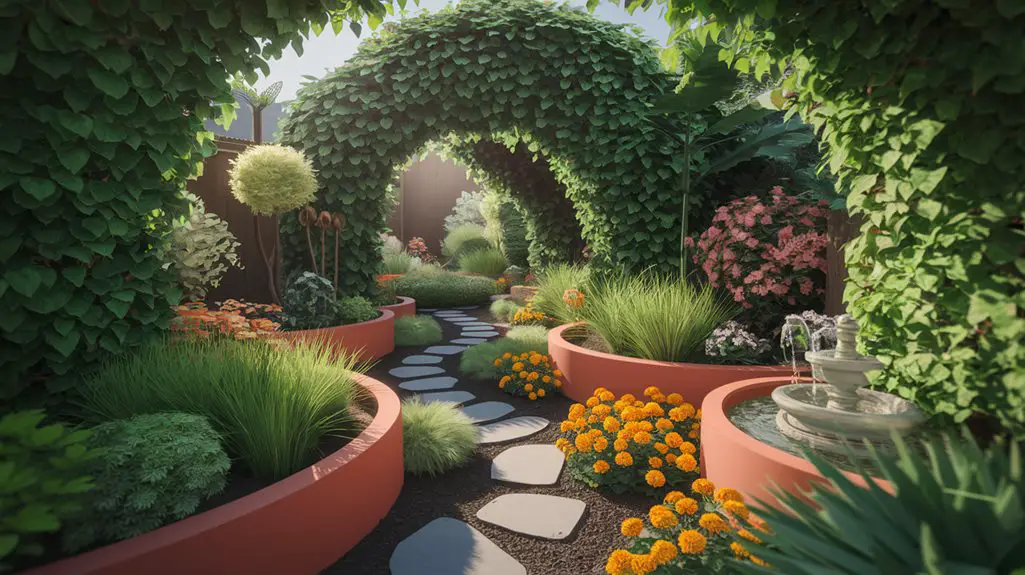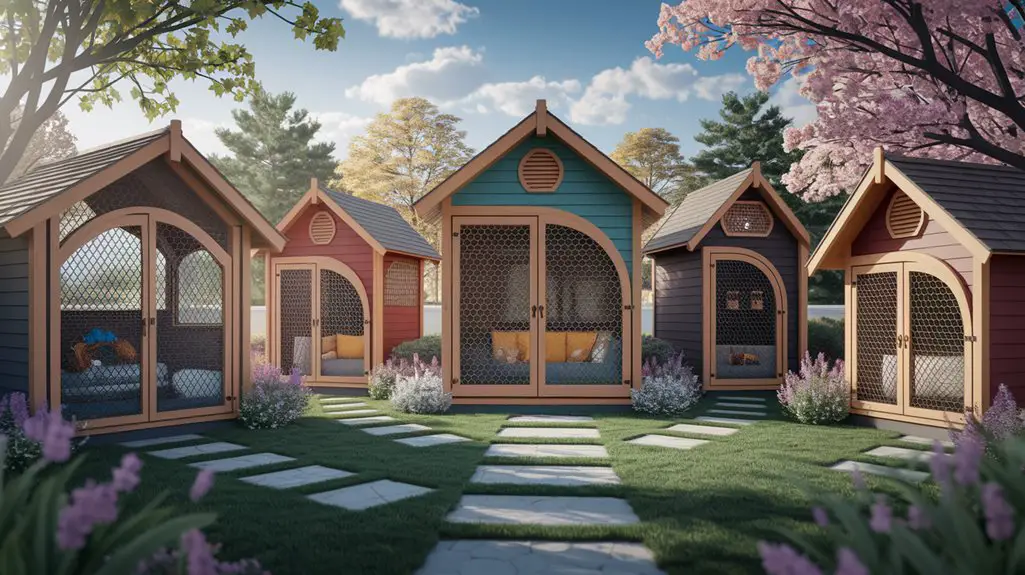A sensory garden offers your pets a controlled yet stimulating environment that engages their natural instincts. You’ll need to take into account your pet’s unique sensory preferences when designing this space—cats may appreciate vertical elements with scent-based attractions, while dogs often respond to varied textures and interactive features. Research confirms that properly designed sensory environments can reduce stress behaviors and improve overall wellbeing in companion animals. The key elements involve more than just aesthetics; they must address safety concerns while maximizing sensory enrichment.
Understanding the Sensory Needs of Different Pets
Why do pets interact with their environments so differently? Their unique sensory capabilities determine how they process stimuli.
Dogs rely primarily on olfaction, with approximately 300 million scent receptors compared to humans’ 6 million. Cats possess specialized vision for low-light conditions and detect high-frequency sounds beyond human hearing range.
Research indicates that sensory preferences vary considerably by species. For example, studies published in Applied Animal Behaviour Science demonstrate that birds primarily process information visually, while reptiles depend heavily on thermoreceptors.
Small mammals such as rabbits and guinea pigs exhibit heightened sensitivity to vibrations and sudden movements.
When designing sensory spaces, consider your pet’s evolutionary adaptations. Provide species-appropriate stimulation: scent stations for canines, elevated viewing perches for felines, and secure hideaways for prey species. Additionally, incorporating species-appropriate stimulation into your design can greatly enhance your pets’ engagement and enjoyment of the space.
Selecting Pet-Safe Plants and Herbs

Creating a sensory environment tailored to your pet’s natural adaptations requires careful consideration of plant materials. When selecting flora for your pet’s garden, prioritize safety while still providing enrichment opportunities.
- Herbs like cat grass, catnip, and valerian appeal to felines through scent and taste, while being non-toxic if ingested.
- For canines, consider chamomile, mint, and rosemary which offer aromatic stimulation without posing significant health risks.
- Avoid common toxic plants including lilies, tulips, azaleas, and sago palms which can cause severe illness or death.
- Research ASPCA’s extensive toxic plant database before introducing any new species to your pet’s environment.
- Incorporate effective natural solutions for pest control to ensure your garden remains safe and healthy for your pets.
Many commercially available plants contain pesticides harmful to animals, so source organically grown varieties whenever possible.
Regularly monitor your pet’s interaction with plants and remove any showing signs of excessive consumption.
Creating Tactile Exploration Zones

Tactile exploration zones serve as essential components of a pet-friendly sensory garden, engaging your animal’s innate desire to investigate varied textures. Research indicates that different substrates stimulate cognitive development and provide environmental enrichment for pets.
| Surface Type | Benefits | Best For |
|---|---|---|
| Sand Pits | Digging opportunity, natural paw exfoliation | Dogs, reptiles |
| Smooth Stones | Temperature variation, massage effect | Cats, small mammals |
| Mulch Areas | Moisture retention, soft walking surface | All pets, arthritis-prone animals |
Incorporate varying heights and depths in your tactile zones to maximize engagement. Consider installing a shallow water feature with gently sloping edges for safe interaction. Always monitor new additions to ascertain your pet responds positively, as individual preferences may vary based on species and personality. Additionally, providing a variety of different substrates can further enhance your pets’ sensory experiences and encourage exploration.
Incorporating Sound Elements for Auditory Stimulation
Sound elements serve as powerful sensory enrichment tools in your pet’s garden, stimulating cognitive function through auditory engagement. Research suggests that varied acoustic experiences can reduce anxiety and promote exploratory behavior in domestic animals. Incorporating pollinator-friendly features can enhance the garden atmosphere, attracting beneficial wildlife that adds to the auditory experience.
When selecting auditory features, consider these evidence-based options:
- Wind chimes with gentle tones (5-7 tubes) positioned at appropriate heights—studies indicate lower frequencies are less startling to sensitive animals.
- Water features with adjustable flow rates that create consistent, calming white noise.
- Bird feeders strategically placed to attract natural wildlife sounds—maintain at safe distances from pet access points.
- Textured pathways (gravel, mulch) that produce different sounds under paws, encouraging proprioceptive awareness.
Always introduce sound elements gradually, monitoring your pet’s reactions to prevent overstimulation or stress responses.
Designing Scent Stations and Aromatic Pathways
While vision and hearing provide essential sensory input for pets, their olfactory systems often represent the most sophisticated and sensitive information-gathering mechanism.
Dogs possess approximately 300 million olfactory receptors compared to humans’ mere 6 million, making scent stations particularly enriching for them.
Consider creating dedicated zones with different aromatic profiles.
Plant herbs like catnip, valerian, and silver vine in elevated planters for felines, while dogs typically respond to anise, mint, and chamomile.
Research indicates that varying scent heights accommodates different species’ natural sniffing behaviors.
Implement aromatic pathways using mulch infused with pet-safe essential oils at dilute concentrations (0.1-0.5%).
Studies suggest rotational introduction of new scents every 2-3 weeks prevents habituation and maintains cognitive stimulation, particularly beneficial for aging pets experiencing sensory decline. Additionally, creating a habitat for beneficial insects can enhance the overall ecosystem of your sensory garden, providing further stimulation for your pets.
Adding Visual Interest With Colors and Movement
Beyond scent enrichment, the visual elements of a pet sensory garden serve as powerful enrichment tools that can facilitate active engagement and mental stimulation.
Visual stimuli can trigger natural instincts and behaviors in pets while providing cognitive enrichment.
- Consider introducing ornamental grasses that sway in the breeze, as research shows movement captures pets’ attention and triggers predatory instincts.
- Select pet-safe plants with varied colors—blues and yellows are most visible to canines, while felines respond to blues and greens.
- Install reflective surfaces such as gazing balls or small mirrors strategically placed at pet height.
- Incorporate butterfly-attracting flowers that create natural movement and additional visual interest without artificial components.
When selecting visual elements, prioritize safety over aesthetics and guarantee all materials are non-toxic and securely installed to prevent injury. Additionally, utilizing fenced yard designs that allow pets to explore freely can enhance their experience in the sensory garden.
Balancing Safety Features With Sensory Enrichment
Although sensory enrichment provides valuable stimulation for pets, it must be carefully balanced with safety considerations to create a garden that’s both engaging and hazard-free.
Begin by selecting non-toxic plants; species like lavender and catnip offer sensory benefits without posing ingestion risks. Research from the ASPCA indicates that secure fencing (minimum 4 feet high for dogs) prevents escape while allowing exploration.
Incorporate rounded edges on hardscaping to prevent injury during play. When introducing water features, make sure they’re shallow (under 2 inches for small pets) to minimize drowning hazards.
Studies show that designated digging areas with loose, pesticide-free soil satisfy natural behaviors safely. Always avoid cocoa mulch, which contains theobromine toxic to dogs, and instead choose pet-safe alternatives like cedar or cypress mulch. Additionally, creating pathways with natural materials not only enhances sensory experiences but also ensures safety for your pets.
Conclusion
You’ll find that a carefully designed sensory garden offers significant enrichment for your pets, potentially reducing anxiety and promoting physical activity. Isn’t it remarkable how environmental stimulation can improve your companion’s overall well-being? Research suggests regular sensory engagement may extend cognitive health in aging pets. Maintain appropriate safety protocols when introducing new elements, and monitor your pet’s interactions—modifying features that cause stress rather than stimulation.



